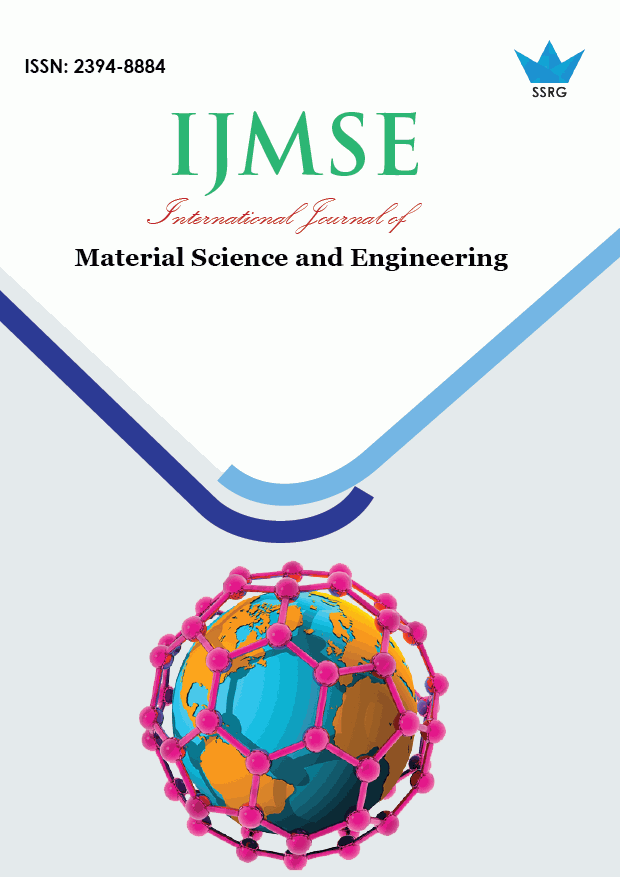Use of Zinc Oxide Nanoparticle for the Removal of Phenol Contaminated Water

| International Journal of Material Science and Engineering |
| © 2017 by SSRG - IJMSE Journal |
| Volume 3 Issue 2 |
| Year of Publication : 2017 |
| Authors : Ihab Hassan, Mustafa Abbas Mustafa and Basheer Elhassan |
How to Cite?
Ihab Hassan, Mustafa Abbas Mustafa and Basheer Elhassan, "Use of Zinc Oxide Nanoparticle for the Removal of Phenol Contaminated Water," SSRG International Journal of Material Science and Engineering, vol. 3, no. 2, pp. 1-5, 2017. Crossref, https://doi.org/10.14445/23948884/IJMSE-V3I5P101
Abstract:
A variety of synthetic organic water pollutants are classified as refractory (or biorefractory) when they're poorly biodegraded. Phenol is one of those organic pollutants that may causes contamination of water and can cause significant problems if present in domestic water supplies. Conventional processes for removing phenol from industrial effluent include extraction, adsorption on activated carbon, steam distillation, bacterial and chemical techniques. Many of these methods suffering from high cost, incompleteness of purification, formation of dangerous by-products, or low efficiency especially when the contaminant present in diluted concentration. This study aims to examine phenol removal efficiency of Zinc Oxide nanoprticles from water containing trace amount of phenol as a modelled organic pollutant. The effect of dose on the removal efficiency was also studied. To perform the objective, a low temperature chemical growth was used to synthesize zinc oxide nanostructures using co- precipitation standard method. Laboratory based experiment model was designed in which deionized water containing a 2 ppm concentration of phenol was contacted with seven different doses of ZnO nanpaticles in powder form for two hours contact time. The final phenol concentrations were evaluated and ZnO degradation efficiency was calculated. Synthesized ZnO nanoparticles were examined using XRD and SEM tests. The photocatalytic degradation of phenol showed high efficiency in the removal of phenol as a modelled refractory organic pollutant.
Keywords:
Water contamination; Phenol; Zinc Oxide Nanoparticles; Degradation efficiency.
References:
[1] S. C.Bhatia, Environmental pollution and control in chemical process industries, Khanna publisher, second edition, Delhi, India2014, pp. 249
[2] J.Michalowicz, W.Duda, Phenols – Sources and Toxicity, Polish J. of Environ. Stud., Vol. 16, No. 3, 2007, pp. 348
[3]D. N.Ghosh,S. K. Ghosh, Air and water pollution control engineering, New Central Book Agenccy, India, 2012, pp. 311
[4] B.Sarma, Refractory Substances and Heavy Metals in Water Environment, Research Scholar, Centre for the Environment, IIT Guwahati,2012 http://iitg.ernet.in/coeiitg/39.pdf date 27/3/2014
[5] B.Sunandan, K. P. Samir and D.Joydeep, Nanostructured zinc oxide for water treatment', Nanoscience and nanotechnology- Asia, Bentham science publisher,2012, vol.2No. 2 http://www.bose.res.in/~skpal/papers/dutta_nanoasia1.pdf. date 22/11/2014
[6] A.Sadollahkhani, M.Willander, I.Kazeminezhad,J. Lu, O.Nur, L.Hultman, Synthesis, structural characterization and photocatalytic application of ZnO@ZnS core–shell Nanoparticles, The Royal Society of Chemistry, 2014.
[7] S.Saeedi, H.Godini, M.Almasian, S. G.Khorramabadi,B.Kamarehie, P.Mostafaie, F.Taher, Photocatalytic degradation of phenol in water solutions using ZnO nanoparticles immobilized on glass, Journal of A dvances in Environmental Health Research, 2015.

 10.14445/23948884/IJMSE-V3I5P101
10.14445/23948884/IJMSE-V3I5P101